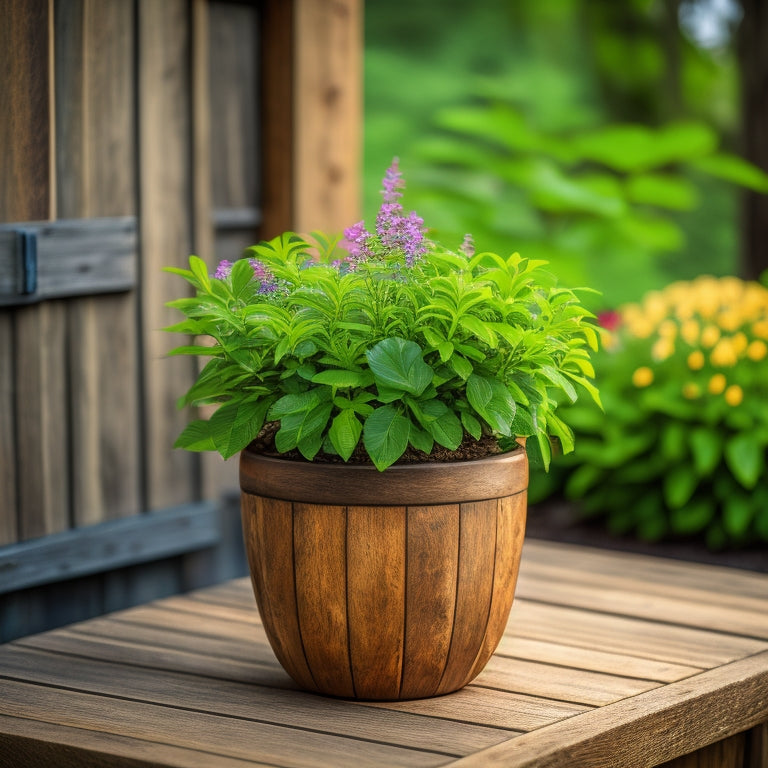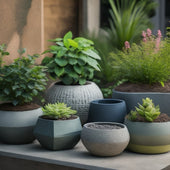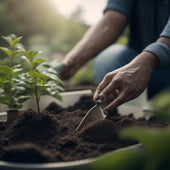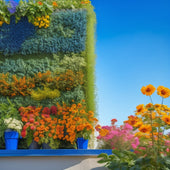
Build a Stunning Planter With These Simple Steps
Share
You'll start by preparing the cinder blocks, inspecting them for debris, cracks, or broken edges, and choosing the right ones based on weight, durability, and texture. Next, you'll lay the foundation base, positioning the first block level and secure, and adding gravel or sand for drainage and soil stability. Then, you'll add a layer of soil and gravel, blending them for ideal plant growth support. As you build, verify each layer is level, secure, and well-drained, and don't be afraid to get creative with your planter's design and decorative elements – the more you focus on the details, the more stunning your planter will be.
Key Takeaways
• Inspect and choose cinder blocks based on weight, durability, and texture to ensure a sturdy foundation for your planter.
• Lay a solid foundation base with gravel or sand for drainage and soil stability, and add cinder blocks in layers, ensuring each layer is level and secure.
• Blend soil and gravel in a 70% soil to 30% gravel ratio to create a well-balanced mix that supports plant growth, and add a 2-3 inch layer of gravel for drainage.
• Assemble planter walls using materials that complement your design, and reinforce corners with brackets or additional support for sturdy joints.
• Add finishing touches by applying waterproof sealant, selecting plants that match your planter design, and incorporating decorative accents for aesthetic appeal.
Prepare the Cinder Blocks
Gather your cinder blocks and inspect them for any debris, cracks, or broken edges, as you'll need a solid foundation for your planter steps.
You'll want to choose the right type of cinder blocks for your project, considering factors like weight, durability, and texture. Standard gray cinder blocks are a popular choice, but you may also opt for more decorative options like split-face or glazed blocks.
Take note of the block's dimensions, as this will impact your planter's overall height. For a more compact design, use smaller blocks or consider a shorter planter height. Conversely, larger blocks will yield a taller planter.
Confirm the blocks you select can support the weight of the soil, plants, and any additional decorative elements.
Before moving forward, double-check that your blocks are clean, dry, and free of any imperfections. This attention to detail will pay off in the long run, as a sturdy foundation is essential for a successful DIY planter project.
Lay the Foundation Base
Place the first cinder block at the bottom center of your planter location, guaranteeing it's level and securely positioned to serve as the foundation's anchor point. This block will set the tone for the rest of your planter's structure, so take your time to get it right.
Next, lay out the remaining foundation materials, such as gravel or sand, to create a solid base. These materials will help with drainage solutions and prevent waterlogged soil. Use the following table as a guide to guarantee your foundation is sturdy and well-draining:
| Material | Quantity | Purpose |
|---|---|---|
| Cinder blocks | 4-6 | Foundation structure |
| Gravel | 1-2 bags | Drainage solutions |
| Sand | 1-2 bags | Base stabilization |
| Weed barrier | 1 roll | Prevents weed growth |
| Landscape fabric | 1 roll | Separates gravel and soil |
Continue to build your foundation by adding more cinder blocks, making sure each layer is level and secure. Remember to check your planter's drainage by pouring water over the foundation materials. If the water drains quickly, you're on the right track!
Add Soil and Gravel Layer
With your foundation structure in place, you'll now add a layer of soil and gravel, carefully blending them to create a well-balanced mix that supports healthy plant growth.
When selecting soil types, consider the specific needs of your plants. For example, if you're planting succulents, you'll want a mix with good drainage to prevent waterlogged soil. For flowering plants, a nutrient-rich soil with good water retention is ideal.
Next, add a layer of gravel, about 2-3 inches deep, to improve drainage solutions. This will help prevent water from accumulating in the soil and reduce the risk of root rot. You can use a general-purpose gravel or a decorative gravel that complements the aesthetic of your planter. Make sure to spread the gravel evenly, guaranteeing it covers the entire surface.
Now, combine the soil and gravel, mixing them thoroughly to create a uniform blend. The ideal ratio is about 70% soil to 30% gravel. This balanced mix will provide the necessary support for your plants to thrive.
As you add the soil-gravel mix, ascertain it's evenly distributed and doesn't exceed the halfway mark of your planter. This will leave enough room for the plants' roots to grow and for future additions of soil or mulch.
Assemble the Planter Walls
You'll now construct the planter walls, using materials that complement your planter's design and the specific needs of your plants.
Consider the design options that best suit your planter's style, such as wooden planks, metal frames, or concrete blocks. Ascertain the materials you choose provide sufficient wall stability to hold the soil and plants securely.
Begin by cutting the materials to the required length and width. Use a level to ascertain the walls are straight and even. Assemble the walls by attaching the individual pieces together using screws, nails, or adhesive, depending on the material. Make sure to leave space for drainage and aeration to prevent waterlogged soil.
Pay attention to the corners, where the walls meet, to ascertain a sturdy joint. Use corner brackets or additional support to reinforce the structure.
As you build the walls, regularly check their stability and make adjustments as needed. A well-constructed planter wall is essential for a thriving garden, so take your time and focus on precision.
Add Finishing Touches
Two coats of waterproof sealant are necessary to protect your planter walls from moisture and guarantee a long-lasting structure.
Apply the sealant according to the manufacturer's instructions, ensuring complete coverage of all surfaces. Once dry, you're ready to add the finishing touches.
Next, select plants that complement your planter's design and the surrounding environment.
Consider factors like sunlight, soil type, and moisture levels when making your plant selection. Arrange the plants thoughtfully, leaving enough space for growth and visual balance.
Add decorative accents to enhance the planter's aesthetic appeal.
You can use items like pebbles, moss, or small ornaments to create a visually appealing contrast. Be mindful of the overall design and balance of the planter, ensuring the accents don't overwhelm the plants or structure.
Frequently Asked Questions
Can I Use Other Materials Instead of Cinder Blocks for the Planter?
You're wondering if you can stray from cinder blocks for your planter. Absolutely!
You can explore alternative materials to achieve the desired planter aesthetics. Consider wooden crates, brick, or even repurposed items like old pallets or boots.
Each material will bring its own unique character to your planter. Just make sure the material you choose is durable, weather-resistant, and can support the weight of your plants.
How Do I Prevent Weeds From Growing in the Planter?
Did you know that weeds can grow up to 1 inch per day?
To prevent them from taking over your planter, you'll need a solid weed control strategy. Start by lining the bottom of your planter with a weed barrier, like landscaping fabric or plastic sheeting.
Then, mulch the top with a thick layer of organic material, like wood chips or bark.
Regular planter maintenance, including watering and pruning, will also help suppress weed growth.
What Type of Plants Are Best Suited for a Cinder Block Planter?
When selecting plants for your cinder block planter, you'll want to prioritize species that thrive in well-draining conditions.
Succulents and cacti are ideal, as they're adapted to store water and won't mind the occasional dry spell.
Consider plants with shallow roots, like creeping thyme or sedum, which won't be hindered by the planter's drainage considerations.
You'll also want to choose varieties that won't outgrow the planter quickly, ensuring a visually appealing display.
Can I Build a Planter on a Slope or Uneven Ground?
You're venturing into uncharted territory, maneuvering the rocky terrain of uneven ground!
Don't let it stump you - with the right strategies, you can conquer the slope.
To build a planter on a slope, you'll need to master slope stabilization techniques, ensuring your structure won't topple.
Next, incorporate drainage solutions to prevent waterlogged soil.
How Do I Protect the Planter From Extreme Weather Conditions?
When building a planter, you'll want to protect it from extreme weather conditions. To do this, you'll need to employ weatherproofing techniques.
Start by applying a waterproof coating to the planter's exterior.
Next, add planter insulation to keep the soil and roots at a stable temperature.
Finally, guarantee proper drainage holes to prevent waterlogging.
Conclusion
You've transformed a pile of humble cinder blocks into a stunning planter, where lush greenery will soon thrive.
Now, imagine the vibrant flowers or leafy greens spilling over the rustic, industrial walls, softening their rugged edges.
The contrast is striking – rough, grey concrete giving way to delicate, colorful life.
Your creation is a beautiful blend of opposites, a demonstration of your creativity and handiwork.
Related Posts
-

5 Best DIY Planter Ideas to Upcycle Concrete
You're about to breathe new life into discarded concrete blocks by transforming them into functional and visually app...
-

5 Best DIY Planter Ideas to Upcycle Concrete
You're about to breathe new life into discarded concrete blocks by transforming them into functional and visually app...
-

5 Best DIY Planter Ideas to Upcycle Concrete
You're about to breathe new life into discarded concrete blocks by transforming them into functional and visually app...
-

5 Best DIY Planter Ideas to Upcycle Concrete
You're about to breathe new life into discarded concrete blocks by transforming them into functional and visually app...
-

5 Best DIY Planter Ideas to Upcycle Concrete
You're about to breathe new life into discarded concrete blocks by transforming them into functional and visually app...
-

5 Best DIY Planter Ideas to Upcycle Concrete
You're about to breathe new life into discarded concrete blocks by transforming them into functional and visually app...
-

5 Best DIY Planter Ideas to Upcycle Concrete
You're about to breathe new life into discarded concrete blocks by transforming them into functional and visually app...
-

5 Best DIY Planter Ideas to Upcycle Concrete
You're about to breathe new life into discarded concrete blocks by transforming them into functional and visually app...
-

5 Best DIY Planter Ideas to Upcycle Concrete
You're about to breathe new life into discarded concrete blocks by transforming them into functional and visually app...
-

5 Best DIY Planter Ideas to Upcycle Concrete
You're about to breathe new life into discarded concrete blocks by transforming them into functional and visually app...
-

5 Best DIY Planter Ideas to Upcycle Concrete
You're about to breathe new life into discarded concrete blocks by transforming them into functional and visually app...
-

5 Best DIY Planter Ideas to Upcycle Concrete
You're about to breathe new life into discarded concrete blocks by transforming them into functional and visually app...
-

5 Best DIY Planter Ideas to Upcycle Concrete
You're about to breathe new life into discarded concrete blocks by transforming them into functional and visually app...
-

5 Best DIY Planter Ideas to Upcycle Concrete
You're about to breathe new life into discarded concrete blocks by transforming them into functional and visually app...
-

5 Best DIY Planter Ideas to Upcycle Concrete
You're about to breathe new life into discarded concrete blocks by transforming them into functional and visually app...
-

5 Best DIY Planter Ideas to Upcycle Concrete
You're about to breathe new life into discarded concrete blocks by transforming them into functional and visually app...
-

5 Best DIY Planter Ideas to Upcycle Concrete
You're about to breathe new life into discarded concrete blocks by transforming them into functional and visually app...
-

5 Best DIY Planter Ideas to Upcycle Concrete
You're about to breathe new life into discarded concrete blocks by transforming them into functional and visually app...
-

5 Best Trowels for Planting in Concrete Planters
When planting in concrete planters, you need a trowel that can handle the harsh conditions and reduce fatigue on your...
-

5 Best Trowels for Planting in Concrete Planters
When planting in concrete planters, you need a trowel that can handle the harsh conditions and reduce fatigue on your...
-

5 Best Trowels for Planting in Concrete Planters
When planting in concrete planters, you need a trowel that can handle the harsh conditions and reduce fatigue on your...
-

5 Best Trowels for Planting in Concrete Planters
When planting in concrete planters, you need a trowel that can handle the harsh conditions and reduce fatigue on your...
-

5 Best Trowels for Planting in Concrete Planters
When planting in concrete planters, you need a trowel that can handle the harsh conditions and reduce fatigue on your...
-

5 Best Trowels for Planting in Concrete Planters
When planting in concrete planters, you need a trowel that can handle the harsh conditions and reduce fatigue on your...
-

5 Best Trowels for Planting in Concrete Planters
When planting in concrete planters, you need a trowel that can handle the harsh conditions and reduce fatigue on your...
-

5 Best Trowels for Planting in Concrete Planters
When planting in concrete planters, you need a trowel that can handle the harsh conditions and reduce fatigue on your...
-

5 Best Trowels for Planting in Concrete Planters
When planting in concrete planters, you need a trowel that can handle the harsh conditions and reduce fatigue on your...
-

5 Best Trowels for Planting in Concrete Planters
When planting in concrete planters, you need a trowel that can handle the harsh conditions and reduce fatigue on your...
-

5 Best Trowels for Planting in Concrete Planters
When planting in concrete planters, you need a trowel that can handle the harsh conditions and reduce fatigue on your...
-

5 Best Trowels for Planting in Concrete Planters
When planting in concrete planters, you need a trowel that can handle the harsh conditions and reduce fatigue on your...
-

5 Best Trowels for Planting in Concrete Planters
When planting in concrete planters, you need a trowel that can handle the harsh conditions and reduce fatigue on your...
-

5 Best Trowels for Planting in Concrete Planters
When planting in concrete planters, you need a trowel that can handle the harsh conditions and reduce fatigue on your...
-

5 Best Trowels for Planting in Concrete Planters
When planting in concrete planters, you need a trowel that can handle the harsh conditions and reduce fatigue on your...
-

5 Best Trowels for Planting in Concrete Planters
When planting in concrete planters, you need a trowel that can handle the harsh conditions and reduce fatigue on your...
-

5 Best Trowels for Planting in Concrete Planters
When planting in concrete planters, you need a trowel that can handle the harsh conditions and reduce fatigue on your...
-

5 Best Trowels for Planting in Concrete Planters
When planting in concrete planters, you need a trowel that can handle the harsh conditions and reduce fatigue on your...
-

5 Tips for Thriving Vertical Vegetable Gardens
To thrive in vertical vegetable gardening, you'll want to choose a planter that meets the unique needs of your veggie...
-

5 Tips for Thriving Vertical Vegetable Gardens
To thrive in vertical vegetable gardening, you'll want to choose a planter that meets the unique needs of your veggie...
-

5 Tips for Thriving Vertical Vegetable Gardens
To thrive in vertical vegetable gardening, you'll want to choose a planter that meets the unique needs of your veggie...
-

5 Tips for Thriving Vertical Vegetable Gardens
To thrive in vertical vegetable gardening, you'll want to choose a planter that meets the unique needs of your veggie...
-

5 Tips for Thriving Vertical Vegetable Gardens
To thrive in vertical vegetable gardening, you'll want to choose a planter that meets the unique needs of your veggie...
-

5 Tips for Thriving Vertical Vegetable Gardens
To thrive in vertical vegetable gardening, you'll want to choose a planter that meets the unique needs of your veggie...
-

5 Tips for Thriving Vertical Vegetable Gardens
To thrive in vertical vegetable gardening, you'll want to choose a planter that meets the unique needs of your veggie...
-

5 Tips for Thriving Vertical Vegetable Gardens
To thrive in vertical vegetable gardening, you'll want to choose a planter that meets the unique needs of your veggie...
-

5 Tips for Thriving Vertical Vegetable Gardens
To thrive in vertical vegetable gardening, you'll want to choose a planter that meets the unique needs of your veggie...
-

5 Tips for Thriving Vertical Vegetable Gardens
To thrive in vertical vegetable gardening, you'll want to choose a planter that meets the unique needs of your veggie...
-

5 Tips for Thriving Vertical Vegetable Gardens
To thrive in vertical vegetable gardening, you'll want to choose a planter that meets the unique needs of your veggie...
-

5 Tips for Thriving Vertical Vegetable Gardens
To thrive in vertical vegetable gardening, you'll want to choose a planter that meets the unique needs of your veggie...
-

5 Tips for Thriving Vertical Vegetable Gardens
To thrive in vertical vegetable gardening, you'll want to choose a planter that meets the unique needs of your veggie...
-

5 Tips for Thriving Vertical Vegetable Gardens
To thrive in vertical vegetable gardening, you'll want to choose a planter that meets the unique needs of your veggie...
-

5 Tips for Thriving Vertical Vegetable Gardens
To thrive in vertical vegetable gardening, you'll want to choose a planter that meets the unique needs of your veggie...
-

5 Tips for Thriving Vertical Vegetable Gardens
To thrive in vertical vegetable gardening, you'll want to choose a planter that meets the unique needs of your veggie...
-

5 Tips for Thriving Vertical Vegetable Gardens
To thrive in vertical vegetable gardening, you'll want to choose a planter that meets the unique needs of your veggie...


